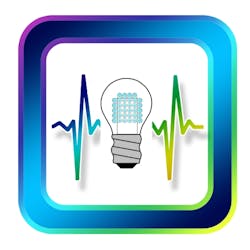European Union organization says LEDs have no direct adverse health effect
The European Union Scientific Committee on Health, Environment and Emerging Risks published research stating that there is no health risk for healthy humans to be exposed to LEDs in the normal use of lighting and display products.
The European Union (EU) Scientific Committee on Health, Environment and Emerging Risks (SCHEER) has published a lengthy draft report entitled “Potential risks to human health of LEDs.” The overall conclusion in the report states. “The Committee concludes that there is no evidence of direct adverse health effects from LEDs in normal use (lighting and displays) by the general healthy population.”
Interested in articles & announcements on research, regulations & lighting standards?
Of course, there has been a long debate in the lighting sector as to whether the short-wavelength blue energy peak associated with most phosphor-converted white LEDs can pose a risk to the human eye as solid-state lighting (SSL) usurps the lighting market. The US Department of Energy (DOE) has addressed the issue several times. And we published several feature articles on the topic including an article about IEC activity in the space. We also published a Q&A session on the topic following a webcast we held a few years back.
The EU had tasked SCHEER with studying the issue exhaustively with the specific direction to evaluate the impact of blue energy on human eyes and skin. The committee determined that typical human exposure to such blue energy from lighting and displays is far lower than exposure safety limits that have been previously established. And the report said the lack of ultraviolet (UV) light in LED sources may reduce the risk humans face from UV in other light sources including the Sun.
The LightingEurope organization has immediately championed the report. “LightingEurope welcomes the conclusion by the Committee that there is no evidence of direct adverse health effects from LEDs in normal use by the general population,” said Ourania Georgoutsakou, secretary general of LightingEurope. “One of the key objectives of LightingEurope is to inform the market on good quality lighting and to support consumers in making informed choices.
Of course, the report is in draft stage, and Georgoutsakou added, “We welcome the initiative of SCHEER to launch a public consultation period, which gives the opportunity for interested stakeholders to provide their feedback.”
The report does warn of potential issues with LEDs including discomfort and disability glare associated with SSL implementations in auto headlamps and other applications. Those issues are solely present in LEDs. The report also mentions glare related to street lighting but points out that glare has been a problem primarily where lighting design and luminaire selection has favored energy efficiency over quality. In any case, the glare issue is said to have a temporary and not permanent impact on healthy humans.
The report further concludes that some LED products can have a greater impact on circadian rhythm relative to legacy sources, yet it goes on to say that there is no current evidence that circadian disturbance leads to adverse health effects. That sure runs contrary to what we hear from many scientists and will be a primary topic at our Lighting for Health and Wellbeing Conference on July 27.
You can peruse the entire 84-page report on an EU website. Note the link is direct to a pdf.

Maury Wright | Editor in Chief
Maury Wright is an electronics engineer turned technology journalist, who has focused specifically on the LED & Lighting industry for the past decade. Wright first wrote for LEDs Magazine as a contractor in 2010, and took over as Editor-in-Chief in 2012. He has broad experience in technology areas ranging from microprocessors to digital media to wireless networks that he gained over 30 years in the trade press. Wright has experience running global editorial operations, such as during his tenure as worldwide editorial director of EDN Magazine, and has been instrumental in launching publication websites going back to the earliest days of the Internet. Wright has won numerous industry awards, including multiple ASBPE national awards for B2B journalism excellence, and has received finalist recognition for LEDs Magazine in the FOLIO Eddie Awards. He received a BS in electrical engineering from Auburn University.





![The DesignLights Consortium continues to make progress in shifting outdoor lighting products and implementation practices toward a more restrained and thoughtful strategy. [Image does not represent a DLC qualified fixture.] The DesignLights Consortium continues to make progress in shifting outdoor lighting products and implementation practices toward a more restrained and thoughtful strategy. [Image does not represent a DLC qualified fixture.]](https://img.ledsmagazine.com/files/base/ebm/leds/image/2024/08/66be810888ae93f656446f61-dreamstime_m_265700653.png?auto=format,compress&fit=&q=45&h=139&height=139&w=250&width=250)